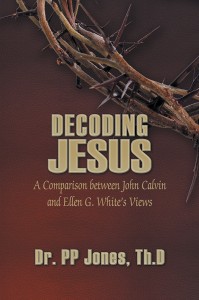 The 16th century John Calvin encountered a theological conundrum. He was unaware that one cannot hold on to the Trinity notion whilst on the other hand operating with the Biblical historical timeline of Creation, Reconciliation (the Cross), Renewal (the Holy Spirit at Pentecost) and Fulfillment (at the end of time). The reason being, the Trinity does not fit well into the biblical historical timeline.
The 16th century John Calvin encountered a theological conundrum. He was unaware that one cannot hold on to the Trinity notion whilst on the other hand operating with the Biblical historical timeline of Creation, Reconciliation (the Cross), Renewal (the Holy Spirit at Pentecost) and Fulfillment (at the end of time). The reason being, the Trinity does not fit well into the biblical historical timeline.
Ellen White, who came almost 300 years later after Calvin, did not follow the tradition of a typical classical Trinitarian notion. In her voluminous writings the word ‘Trinity’ is conspicuously missing. White visited Switzerland, where Calvin spent most of his life as a Reformer. She studiously looked into Calvin’s life and theology and most likely saw Calvin’s and the Reformation’s mistake with regard to the ‘Trinity’. That is probably one of the reasons why in her major work, The Great Controversy (1990,236), she wrote concerning Calvin: ‘His course as a public leader was not faultless, nor were his doctrines free from error’.
Some prominent scholars in the Adventist Church have been accused of selling the birth-right of the Church for the sake of public relations (supposedly in order to be accepted by the Mainline Churches). Early Adventists did not espouse themselves to the doctrine of the Trinity.
The problem facing the entire Christian Church today is that the doctrine of the Trinity continues being controversial as it has always been controversial from the offset. The Trinity notion which bares resemblances outside of Christianity was formulated over various Church Councils that were polluted by politics and corruption.
In Decoding Jesus, a problem arises when some scholars try to make the ‘Trinity’ as Ellen White’s main reflexive scheme in her faith studies. Ellen G. White was not a traditional Trinitarian. The closest we could call her is being “a Trinitarian, open-ended”, and thereby acknowledging her reflexive method — the biblical historical timeline from Genesis to Revelation. Furthermore, the idea that One God equals Three (which is a fist millennium formula), should haunt anyone living in the 21st century.
God’s Grand Acts in the biblical historical timeline of the Judeo-Christian Bible are: Creation; Reconciliation (the Son/ Cross); Renewal (The Holy Spirit /Pentecost) and Fulfillment (the End of time into eternity). The traditional Trinity formula is: God the Father; God the Son and God the Holy Spirit. In other words there are three divine beings only. This does not fit well into the biblical historical timeline. Why? If Creation is linked to God the Father; Reconciliation to God the Son; Renewal to God the Holy Spirit, Fulfillment also needs another divine person into the end time through into eternity!
Secondly, even if we did not consider another divine person for Fulfillment (end time and eternity), if one tries to fit divinity into the biblical historical timeline, then the formula would be: God the Father; God the Son-divine and human and God the Holy Spirit. Ellen White and Calvin glued together the divine and human natures of the one person Jesus Christ all the way into eternity. This makes it non Trinitarian. The Trinity notion does not subscribe to the Son as = divinity + humanity into eternity!
Ellen G. White saw Calvin’s and the Reformation’s contradiction and wanted to avoid the same trap!
Karl Barth the great Swiss theologian of the 20th century also saw Calvin’s theological conundrum with regard to the Trinity notion. He gave the Trinity a biblical vote of no confidence,—stating: The Trinity cannot be found anywhere in the Bible. It can only be regarded as a good dogma [My own Translation].
